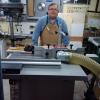As most everyone knows, I'm still working on a staircase that has been kicking my butt for more than two months. (I'll be done in two weeks, I'm pretty sure.)
Yes, I'm a n00b. But I'm very happy with my results so far. So is LOML. I run with the slogan, "Perfect is good enough."
Lately, I've been measuring in centimeters and millimeters because it is significantly easier. I'm quite sick of subtracting sixteenths from quarters. It is a ridiculous system.
My work has become much more precise since using the "metric" side of my tapes and straightedges. I've always been good with celsius degrees, liters and kilograms. But I've clung my whole life to inches and feet. No longer. I can't stand thinking of "1 and 1/8 plus a bit less than a 16th"
So my question is:
How many of y'all "educated in the USA" woodworkers have ditched inches for centimeters?
Is there a down side that I haven't considered?





 Reply With Quote
Reply With Quote







